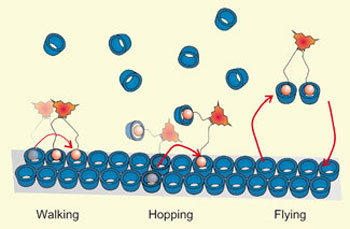 Controlling how molecules move on surfaces could be the key to more potent drugs that block the attachment of viruses to cells, and will also speed development of new materials for electronics and energy applications.
Controlling how molecules move on surfaces could be the key to more potent drugs that block the attachment of viruses to cells, and will also speed development of new materials for electronics and energy applications.
Apr 8th, 2011
Read more
Exactly 100 years ago today, physicist Kamerlingh Onnes cooled mercury to 4.2 degrees Kelvin, or -450 Fahrenheit, and discovered that it conducted an electric current perfectly - no electricity was lost as heat or friction. This phenomenon is called superconductivity.
Apr 8th, 2011
Read more
To train new scientists and engineers to combat the spread of cancer, Johns Hopkins Institute for NanoBioTechnology (INBT) has established a pre-doctoral (PhD) training program in Nanotechnology for Cancer Medicine. Together with the institute's previously established Nanotechnology for Cancer Medicine postdoctoral fellowship, these two training programs will comprise the Johns Hopkins Cancer Nanotechnology Training Center (CNTC).
Apr 8th, 2011
Read more
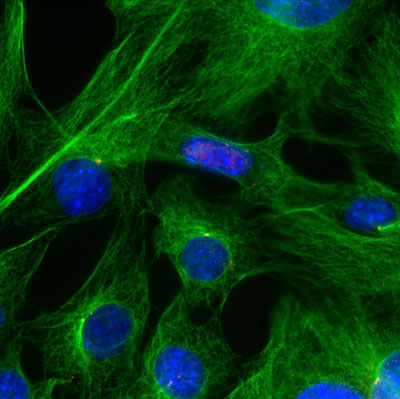 Nanotechnology for Cancer Medicine forms the focus of the fifth annual symposium of Johns Hopkins Institute for NanoBioTechnology (INBT), May 12-13, 2011 at the university's Homewood campus.
Nanotechnology for Cancer Medicine forms the focus of the fifth annual symposium of Johns Hopkins Institute for NanoBioTechnology (INBT), May 12-13, 2011 at the university's Homewood campus.
Apr 8th, 2011
Read more
To address occupational risks of nanomaterials, WHO is developing Guidelines to "Protecting Workers from Potential Risks of Manufactured Nanomaterials" (WHO/NANOH). These Guidelines aim to facilitate improvements in occupational health and safety of workers potentially exposed to nanomaterials in a broad range of manufacturing and social environments.
Apr 8th, 2011
Read more
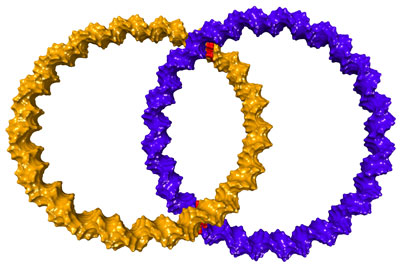 Wissenschaftlern an der Goethe-Universitaet ist es gelungen, zwei nur 18 Nanometer grosse Ringe aus DNA herzustellen und sie wie zwei Kettenglieder ineinander greifen zu lassen.
Wissenschaftlern an der Goethe-Universitaet ist es gelungen, zwei nur 18 Nanometer grosse Ringe aus DNA herzustellen und sie wie zwei Kettenglieder ineinander greifen zu lassen.
Apr 8th, 2011
Read more
A total of more than 1000 researchers coming from more than 70 major European research institutes in the field of energy are involved in the different EERA Joint Programmes. These scientists are working to accelerate the delivery to industry of a new generation of energy technologies to contribute to achieving the 20-20-20 targets.
Apr 8th, 2011
Read more
A research team at the University of Pennsylvania's schools of Engineering and Applied Science and Arts and Sciences has shown how to control the characteristics of semiconductor nanowires made of a promising material: lead selenide.
Apr 8th, 2011
Read more
DARPA's Systems of Neuromorphic Adaptive Plastic Scalable Electronics (SyNAPSE) program aims to fundamentally alter conventional designs by developing biological-scale neuromorphic electronic systems that mimic important functions of a human brain. Applications for neuromorphic electronics include robotic and manned systems, and sensory and integration applications such as image processing.
Apr 8th, 2011
Read more
Recently, new achievements were made in the integrated optics by the Creative Research Group of Femtosecond Photophysics and Integrated Optics at Peking University. The group realized a novel nanoscale integrated all-optical diode having ultralow power and ultrahigh transmission contrast after the realization of the all-optical switch device with ultralow power and high-speed photonic crystal.
Apr 8th, 2011
Read more
The collaborative initiative involving leading academics and industrialists, led by the University of Strathclyde in Glasgow, is seeking quicker, more effective and more sustainable methods of manufacturing products such as medicines, foodstuffs, dyes, pigments and nanomaterials.
Apr 8th, 2011
Read more
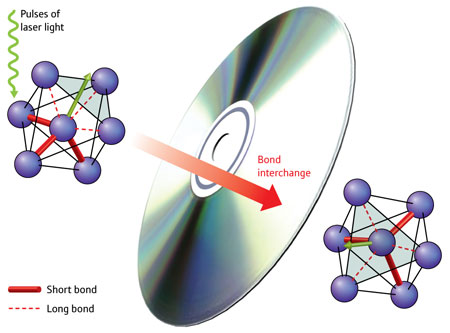 Revelation of the crystallization mechanism that enables fast writing of data to DVDs shows potential for quicker data storage in the future.
Revelation of the crystallization mechanism that enables fast writing of data to DVDs shows potential for quicker data storage in the future.
Apr 8th, 2011
Read more
The German Center for Research and Innovation (GCRI), in cooperation with the Consortium of the Ruhr Universities (ConRuhr) and the Consulate General of the Federal Republic of Germany, will host a discussion on nanotechnology and its applications in the fields of energy, electronics, medicine, and science.
Apr 8th, 2011
Read more
How to put more bang in your biofuels? Nanoparticles! A new study shows that the addition of alumina nanoparticles can improve the performance and combustion of biodiesel, while producing fewer emissions.
Apr 8th, 2011
Read more
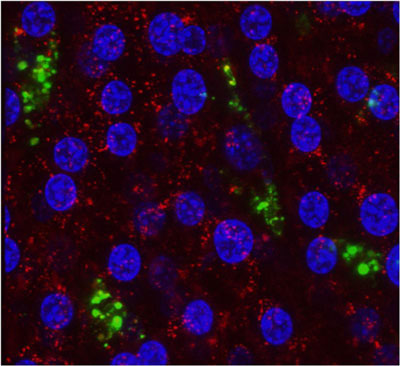 Vom 7. bis 9. April 2011 findet im Bernhard-Nocht-Institut fuer Tropenmedizin in Hamburg erstmals ein Symposium des Sonderforschungsbereiches 841 "Leberentzuendung: Infektion, Immunregulation und Konsequenzen" (SFB 841) statt.
Vom 7. bis 9. April 2011 findet im Bernhard-Nocht-Institut fuer Tropenmedizin in Hamburg erstmals ein Symposium des Sonderforschungsbereiches 841 "Leberentzuendung: Infektion, Immunregulation und Konsequenzen" (SFB 841) statt.
Apr 8th, 2011
Read more
IBM's announcement of the first biodegradable nanoparticles that can seek out and destroy drug-resistant bacteria caps off a century of healthcare and life sciences innovation from IBM. To celebrate IBM's Centennial, the company is unveiling an "icon of progress" representing IBM's contributions to fighting infectious diseases and contributions to world health.
Apr 7th, 2011
Read more
 Controlling how molecules move on surfaces could be the key to more potent drugs that block the attachment of viruses to cells, and will also speed development of new materials for electronics and energy applications.
Controlling how molecules move on surfaces could be the key to more potent drugs that block the attachment of viruses to cells, and will also speed development of new materials for electronics and energy applications.




 Subscribe to our Nanotechnology News feed
Subscribe to our Nanotechnology News feed